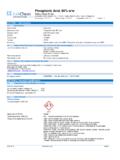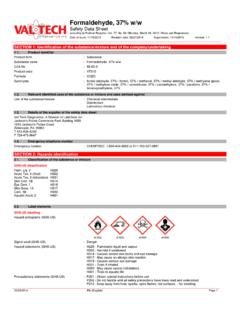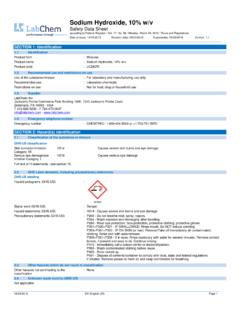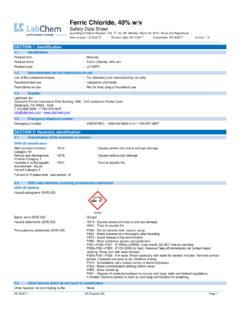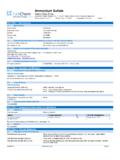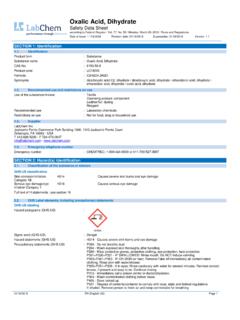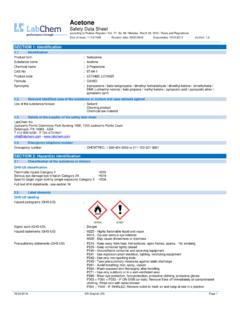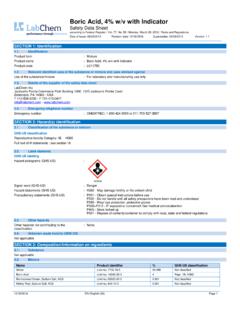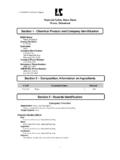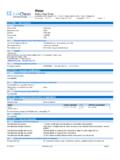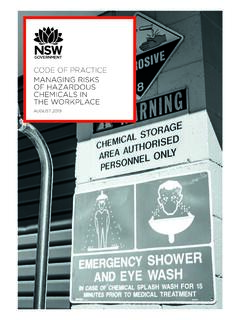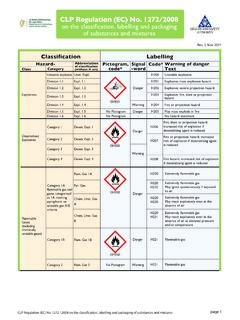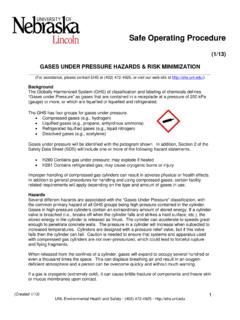Transcription of Isopropyl Alcohol (2-Propanol)
1 Isopropyl Alcohol (2- propanol ). Safety Data Sheet according to Federal Register / Vol. 77, No. 58 / Monday, March 26, 2012 / Rules and Regulations Date of issue: 11/14/2013 Revision date: 01/26/2018 Supersedes: 09/29/2015 Version: SECTION 1: Identification Identification Product form : Substance Substance name : Isopropyl Alcohol (2- propanol ). CAS-No. : 67-63-0. Product code : LC15750. Formula : C3H8O. Synonyms : 1-methylethanol / 1-methylethyl Alcohol / 2-hydroxypropane / dimethyl carbinol / ethyl carbinol /. hydroxypropane / IPA / i- propanol / isoethylcarbinol / propan-2-ol / sec- propanol Recommended use and restrictions on use Use of the substance/mixture : Disinfectant Solvent Supplier LabChem Inc Jackson's Pointe Commerce Park Building 1000, 1010 Jackson's Pointe Court Zelienople, PA 16063 - USA. T 412-826-5230 - F 724-473-0647. - Emergency telephone number Emergency number : CHEMTREC: 1-800-424-9300 or 011-703-527-3887. SECTION 2: Hazard(s) identification Classification of the substance or mixture GHS-US classification Flammable liquids H225 Highly flammable liquid and vapour Category 2.
2 Serious eye damage/eye H319 Causes serious eye irritation irritation Category 2A. Specific target organ H335 May cause respiratory irritation toxicity (single exposure). Category 3. Full text of H statements : see section 16. GHS Label elements, including precautionary statements GHS-US labeling Hazard pictograms (GHS-US) : GHS02 GHS07. Signal word (GHS-US) : Danger Hazard statements (GHS-US) : H225 - Highly flammable liquid and vapour H319 - Causes serious eye irritation H335 - May cause respiratory irritation Precautionary statements (GHS-US) : P210 - Keep away from heat, hot surfaces, open flames, sparks. - No smoking. P233 - Keep container tightly closed. P240 - Ground/bond container and receiving equipment. P241 - Use explosion-proof electrical, lighting, ventilating equipment P242 - Use only non-sparking tools. P243 - Take precautionary measures against static discharge. P261 - Avoid breathing mist, vapors, spray. P264 - Wash exposed skin thoroughly after handling.
3 P271 - Use only outdoors or in a well-ventilated area. P280 - Wear eye protection, face protection, protective clothing, protective gloves. P303+P361+P353 - IF ON SKIN (or hair): Remove/Take off immediately all contaminated clothing. Rinse skin with water/shower. P305+P351+P338 - If in eyes: Rinse cautiously with water for several minutes. Remove contact 01/26/2018 EN (English US) Page 1. Isopropyl Alcohol (2- propanol ). Safety Data Sheet according to Federal Register / Vol. 77, No. 58 / Monday, March 26, 2012 / Rules and Regulations lenses, if present and easy to do. Continue rinsing P312 - Call a POISON CENTER or doctor/physician if you feel unwell. P337+P313 - If eye irritation persists: Get medical advice/attention. P370+P378 - In case of fire: Use dry chemical powder, Alcohol -resistant foam, carbon dioxide (CO2) to extinguish P403+P233 - Store in a well-ventilated place. Keep container tightly closed. P405 - Store locked up. P501 - Dispose of contents/container to comply with local, state and federal regulations P235 - Keep cool.
4 If inhaled: Remove person to fresh air and keep comfortable for breathing Other hazards which do not result in classification Other hazards not contributing to the : None. classification Unknown acute toxicity (GHS US). Not applicable SECTION 3: Composition/Information on ingredients Substances Substance type : Mono-constituent Name Product identifier % GHS-US classification Isopropyl Alcohol (2- propanol ) (CAS-No.) 67-63-0 100 Flam. Liq. 2, H225. (Main constituent) Eye Irrit. 2A, H319. STOT SE 3, H335. Full text of hazard classes and H-statements : see section 16. Mixtures Not applicable SECTION 4: First-aid measures Description of first aid measures First-aid measures general : Check the vital functions. Unconscious: maintain adequate airway and respiration. Respiratory arrest: artificial respiration or oxygen. Cardiac arrest: perform resuscitation. Victim conscious with labored breathing: half-seated. Victim in shock: on his back with legs slightly raised. Vomiting: prevent asphyxia/aspiration pneumonia.
5 Prevent cooling by covering the victim (no warming up). Keep watching the victim. Give psychological aid. Keep the victim calm, avoid physical strain. Depending on the victim's condition: doctor/hospital. Never give Alcohol to drink. First-aid measures after inhalation : Remove the victim into fresh air. Respiratory problems: consult a doctor/medical service. First-aid measures after skin contact : Rinse with water. Soap may be used. Do not apply (chemical) neutralizing agents. Take victim to a doctor if irritation persists. First-aid measures after eye contact : Rinse immediately with plenty of water. Do not apply neutralizing agents. Take victim to an ophthalmologist if irritation persists. First-aid measures after ingestion : Rinse mouth with water. Immediately after ingestion: give lots of water to drink. Do not induce vomiting. Give activated charcoal. Call Poison Information Centre ( ). Consult a doctor/medical service if you feel unwell. Ingestion of large quantities: immediately to hospital.
6 Doctor: gastric lavage. Most important symptoms and effects (acute and delayed). Symptoms/effects after inhalation : EXPOSURE TO HIGH CONCENTRATIONS: Coughing. Dry/sore throat. Central nervous system depression. Dizziness. Headache. Narcosis. Symptoms/effects after skin contact : Dry skin. Symptoms/effects after eye contact : Irritation of the eye tissue. Symptoms/effects after ingestion : AFTER ABSORPTION OF LARGE QUANTITIES: Central nervous system depression. Headache. Dilation of the blood vessels. Low arterial pressure. Nausea. Vomiting. Abdominal pain. Disturbed motor response. Disturbances of consciousness. FOLLOWING SYMPTOMS. MAY APPEAR LATER: Body temperature fall. Slowing respiration. Chronic symptoms : ON CONTINUOUS/REPEATED EXPOSURE/CONTACT: Red skin. Dry skin. Itching. Cracking of the skin. Skin rash/inflammation. Impaired memory. Immediate medical attention and special treatment, if necessary No additional information available 01/26/2018 EN (English US) 2/9.
7 Isopropyl Alcohol (2- propanol ). Safety Data Sheet according to Federal Register / Vol. 77, No. 58 / Monday, March 26, 2012 / Rules and Regulations SECTION 5: Fire-fighting measures Suitable (and unsuitable) extinguishing media Suitable extinguishing media : Water spray. Polyvalent foam. Alcohol -resistant foam. BC powder. Carbon dioxide. Unsuitable extinguishing media : Solid water jet ineffective as extinguishing medium. Specific hazards arising from the chemical Fire hazard : DIRECT FIRE HAZARD. Highly flammable. Gas/vapor flammable with air within explosion limits. INDIRECT FIRE HAZARD. May be ignited by sparks. Gas/vapor spreads at floor level: ignition hazard. Explosion hazard : DIRECT EXPLOSION HAZARD. Gas/vapour explosive with air within explosion limits. INDIRECT EXPLOSION HAZARD. may be ignited by sparks. Reactions with explosion hazards : see "Reactivity Hazard". Reactivity : Upon combustion: CO and CO2 are formed. Violent to explosive reaction with (strong).
8 Oxidizers. Prolonged storage/in large quantities: may form peroxides. Special protective equipment and precautions for fire-fighters Firefighting instructions : Cool tanks/drums with water spray/remove them into safety. Do not move the load if exposed to heat. Protection during firefighting : Heat/fire exposure: compressed air/oxygen apparatus. SECTION 6: Accidental release measures Personal precautions, protective equipment and emergency procedures For non-emergency personnel Protective equipment : Gloves. Protective goggles. Protective clothing. Large spills/in enclosed spaces: compressed air apparatus. See "Material-Handling" to select protective clothing. Emergency procedures : Keep upwind. Mark the danger area. Consider evacuation. Seal off low-lying areas. Close doors and windows of adjacent premises. Stop engines and no smoking. No naked flames or sparks. Spark- and explosion-proof appliances and lighting equipment. Keep containers closed. Wash contaminated clothes.
9 For emergency responders Protective equipment : Equip cleanup crew with proper protection. Do not breathe gas, fumes, vapor or spray. Emergency procedures : Stop leak if safe to do so. Ventilate area. If a major spill occurs, all personnel should be immediately evacuated and the area ventilated. Environmental precautions Prevent spreading in sewers. Methods and material for containment and cleaning up For containment : Contain released substance, pump into suitable containers. Consult "Material-handling" to select material of containers. Plug the leak, cut off the supply. Dam up the liquid spill. Try to reduce evaporation. Measure the concentration of the explosive gas-air mixture. Dilute/disperse combustible gas/vapour with water curtain. Provide equipment/receptacles with earthing. Do not use compressed air for pumping over spills. Methods for cleaning up : Take up liquid spill into absorbent material, : dry sand/earth/vermiculite or powdered limestone. Scoop absorbed substance into closing containers.
10 See "Material-handling" for suitable container materials. Damaged/cooled tanks must be emptied. Do not use compressed air for pumping over spills. Carefully collect the spill/leftovers. Clean contaminated surfaces with an excess of water. Take collected spill to manufacturer/competent authority. Wash clothing and equipment after handling. Reference to other sections No additional information available SECTION 7: Handling and storage Precautions for safe handling Precautions for safe handling : Comply with the legal requirements. Remove contaminated clothing immediately. Clean contaminated clothing. Handle uncleaned empty containers as full ones. Thoroughly clean/dry the installation before use. Do not discharge the waste into the drain. Do not use compressed air for pumping over. Use spark-/explosionproof appliances and lighting system. Take precautions against electrostatic charges. Keep away from naked flames/heat. Keep away from ignition sources/sparks. Observe normal hygiene standards.
